Janet Roberts's Blog, page 9
May 18, 2015
Chatsworth International Horse Trials - Derbyshire
 I'd never been to this event, so as it was a lovely day I thought I'd head that way. According to the most informative programme eventing is along-established sport, and has been part of the Olympic movement for over 100 years, since 1912, and took off in this country largely thanks to the intervention of the late Duke of Beaufort who in 1949 created Badminton Horse Trials, now the most prestigious event in the world.
I'd never been to this event, so as it was a lovely day I thought I'd head that way. According to the most informative programme eventing is along-established sport, and has been part of the Olympic movement for over 100 years, since 1912, and took off in this country largely thanks to the intervention of the late Duke of Beaufort who in 1949 created Badminton Horse Trials, now the most prestigious event in the world.In those days, eventing was mainly a male-dominated sport for army officers; it was not until the 1960s that women were allowed to compete at the Olympics. Soon competitors were arriving, by boat, from all over the world as Britain was regarded the place to be!
The sport is also unique in that 'professional' and 'amateur' riders compete against each other at all levels, and men and womenare treated equally.
As soon as I arrived I saw crowds had gathered at Queen Mary's Bower, and I soon realised why, as this was the water splash - and what fun it was!
Then it was time for lunch, and there was every food imaginable on sale - definitely something for everyone. I ate my hot Cornish Pastie sitting listening to excellent music from the specially-erected 'Band Stand'. (Don't know who they were - but they were very good.)
Then it was back to the horses - this time sitting comfortably in the grandstand overlooking the ring containing all the jumps. (I wouldn't never remember the complicated way round the course, let alone be able to do it!)
I was particularly taken with this unusually marked horse - never seen one which like it.
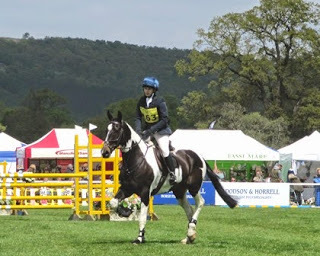
Then it was a quick look at the vast number of trade stands and the craft tent, before settling down to watch the Dressage. This is so impressive - totally silent, and very complicated and difficult.
What I couldn't get over was the fact that it's the same horse and the same rider for all these disciplines, although they seem to me to require such completely different skills, temperament and ability. Amazing and very impressive.
Of course I'd seen Eventing on TV, but how different it was to actually be there, what with the atmosphere and general excitement.
Now I can't wait until next year to do it all over again!
***If you'd like to know more about me and my writing just click here
Published on May 18, 2015 02:30
May 14, 2015
Richard III's tomb - Leicester Cathedral - Leicestershire
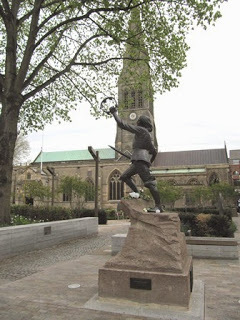 I couldn't wait to visit Richard III's final resting place in Leicester Cathedral having being to Leicester for the reinternment - see previous blog. However, I couldn't believe how hard it was to find the Cathedral for unlike say York or Lincoln, it isn't high on a hill, and clearly dominating the skyline. In fact I felt rather stupid having to ask where it was! There certainly were very few signs!
I couldn't wait to visit Richard III's final resting place in Leicester Cathedral having being to Leicester for the reinternment - see previous blog. However, I couldn't believe how hard it was to find the Cathedral for unlike say York or Lincoln, it isn't high on a hill, and clearly dominating the skyline. In fact I felt rather stupid having to ask where it was! There certainly were very few signs!However, once I'd managed to find the right place I immediately recognised it from the TV coverage surrounding the discovery of the King's skeleton. Having been into the most interesting Visitor Centre, (see see previous blog), I walked passed the famous statue of the King which was donated to Leicester city by the Richard III Society in 1980, and is still dotted with white roses presumably brought by passing visitors.
Inside the surprisingly small Cathedral there was a warm welcome, and to my considerable delight, an organist immediately started playing, really adding considerably to the atmosphere, and the sheer enjoyment of the experience. The tomb itself is very simple being made from a two-tonne block of pale Swaledale fossil limestone, with a deeply incised cross. (I found it fascinating that, like most visitors, I just had to touch the cool stone and look for fossils!) The dark plinth is made from Kilkenny stone.
To my considerable delight, also on display, within a glass display case, was the wonderful Pall that had covered the wooden coffin of this the last Plantagenet King who was killed in the Battle of Bosworth in 1485, but whose remains were not found until 2012, and then under a council car park!
The explanation at the end of the Pall reads:
"The Pall on display was made by Jacquie Binns, and was specially commissioned to cover the coffin containing the mortal remains of King Richard III in the period between its entry into the Cathedral on 22 March and it re-internment on 26 March 2015.
In medieval times a pall was used to cover the coffin of a high status person, prior to their burial, and would usually have been reused many times. This pall consists of a series of figures sewn onto black velvet, and features seraphin, representations of groups from medieval times and also embroideries of important characters associated with the discovery and reinternment of Richard III."
The crown is made of gold, garnet and sapphire and was a gift paid for by Dr John Ashdown-Hill who worked with Philippa Langley to identify distant relatives of the Plantagenet monarch, which led to his identification.
I thought it all quite marvellous, and very unique - and was so glad I'd made the special trip to Leicester to see it for myself.
***If you would like to know more about me and my writing just click here
Published on May 14, 2015 06:27
Richrad III's tomb - Leicester Cathedral - Leicestershire
 I couldn't wait to visit Richard III's final resting place in Leicester Cathedral having being to Leicester for the reinternment - see previous blog. However, I couldn't believe how hard it was to find the Cathedral for unlike say York or Lincoln, it isn't high on a hill, and clearly dominating the skyline. In fact I felt rather stupid having to ask where it was! There certainly were very few signs!
I couldn't wait to visit Richard III's final resting place in Leicester Cathedral having being to Leicester for the reinternment - see previous blog. However, I couldn't believe how hard it was to find the Cathedral for unlike say York or Lincoln, it isn't high on a hill, and clearly dominating the skyline. In fact I felt rather stupid having to ask where it was! There certainly were very few signs!However, once I'd managed to find the right place I immediately recognised it from the TV coverage surrounding the discovery of the King's skeleton. Having been into the most interesting Visitor Centre, (see see previous blog), I walked passed the famous statue of the King which was donated to Leicester city by the Richard III Society in 1980, and is still dotted with white roses presumably brought by passing visitors.
Inside the surprisingly small Cathedral there was a warm welcome, and to my considerable delight, an organist immediately started playing, really adding considerably to the atmosphere, and the sheer enjoyment of the experience. The tomb itself is very simple being made from a two-tonne block of pale Swaledale fossil limestone, with a deeply incised cross. (I found it fascinating that, like most visitors, I just had to touch the cool stone and look for fossils!) The dark plinth is made from Kilkenny stone.
To my considerable delight, also on display, within a glass display case, was the wonderful Pall that had covered the wooden coffin of this the last Plantagenet King who was killed in the Battle of Bosworth in 1485, but whose remains were not found until 2012, and then under a council car park!
The explanation at the end of the Pall reads:
"The Pall on display was made by Jacquie Binns, and was specially commissioned to cover the coffin containing the mortal remains of King Richard III in the period between its entry into the Cathedral on 22 March and it re-internment on 26 March 2015.
In medieval times a pall was used to cover the coffin of a high status person, prior to their burial, and would usually have been reused many times. This pall consists of a series of figures sewn onto black velvet, and features seraphin, representations of groups from medieval times and also embroideries of important characters associated with the discovery and reinternment of Richard III."
The crown is made of gold, garnet and sapphire and was a gift paid for by Dr John Ashdown-Hill who worked with Philippa Langley to identify distant relatives of the Plantagenet monarch, which led to his identification.
I thought it all quite marvellous, and very unique - and was so glad I'd made the special trip to Leicester to see it for myself.
***If you would like to know more about me and my writing just click here
Published on May 14, 2015 06:27
May 10, 2015
Bodgers Ball - Walesby - Nottinghamshire
After the awfulness of the general election, with their smooth news bites and phony promises, what a treat to go to an event with genuine, friendly, skilled people. It was a small piece in the local newspaper that had attracted my attention, and I knew that 'Bodgers' were Pole-lathe Turners, although I had little idea what to expect.
According to the newspaper the Bodgers Ball is the official Association of Pole-lathe Turners & Greenwood Workers (APTGW) annual gathering, promoting green woodworking and all its associated crafts, nurturing and valuing woodlands as a source of employ-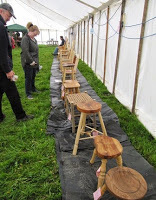
ment and enjoyment while making sure crafts, once at risk of being lost forever, are passed on through future generations.
It turned out to be a much bigger event than I had expected, with a large marque housing tables full of competition sections, such a spoons, bowls etc. My absolute favourite was the long row of stools and chairs, which were absolutely exquisite and must have taken so much time and skill to create. How I would have loved to have owned one of these!
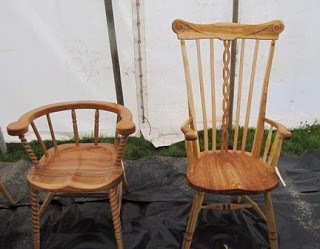

There was also an impressive range of tools - clearly this can be quite an expensive hobby.
Then it was outside where numerous skilled craftsmen were set up demonstrating their craft. I even had a go at making a bit of nettle string, of which I was inordinately proud!
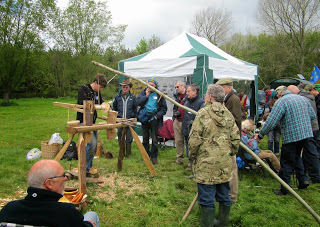
There was excellent hot food and drink available, so altogether this was a marvellous trip out and I couldn't have enjoyed it more.
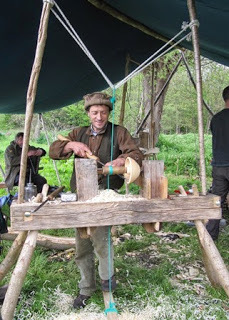 ***If you would like to know more about me and my writing just click here
***If you would like to know more about me and my writing just click here
According to the newspaper the Bodgers Ball is the official Association of Pole-lathe Turners & Greenwood Workers (APTGW) annual gathering, promoting green woodworking and all its associated crafts, nurturing and valuing woodlands as a source of employ-

ment and enjoyment while making sure crafts, once at risk of being lost forever, are passed on through future generations.
It turned out to be a much bigger event than I had expected, with a large marque housing tables full of competition sections, such a spoons, bowls etc. My absolute favourite was the long row of stools and chairs, which were absolutely exquisite and must have taken so much time and skill to create. How I would have loved to have owned one of these!


There was also an impressive range of tools - clearly this can be quite an expensive hobby.
Then it was outside where numerous skilled craftsmen were set up demonstrating their craft. I even had a go at making a bit of nettle string, of which I was inordinately proud!

There was excellent hot food and drink available, so altogether this was a marvellous trip out and I couldn't have enjoyed it more.
 ***If you would like to know more about me and my writing just click here
***If you would like to know more about me and my writing just click here
Published on May 10, 2015 00:56
May 6, 2015
Richard III Visitor Centre - Leicester.
When I went to the re-internment of King Richard III (see previous blog)I felt the newly opened Visitor Centre would be too crowded, and didn't fancy queuing! Consequently recently I made a special trip to the lovely city of Leicester to visit this specially created Centre.
The Visitor Centre stands of the site of the former Alderman Newton's School, located right next to the spot where the king's remains were found. The former school - a stunning Victorian Gothic revival building built partly on the site of the former Grey Friars Church had stood empty since 2008 when its lat occupants, Leicester Grammar School, moved.
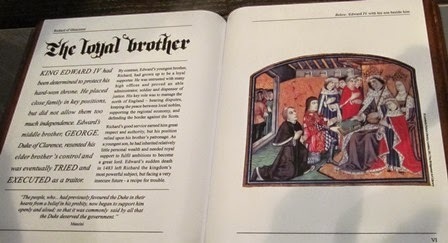 After a warm welcome from the staff, I entered a small area where a film was somehow being played onto the walls of the building, with actors introducing Richard III as a small child. From there it was into a darkened area where there were things to swish, press and generally be fascinated by! This video is typical of the modern technology used to interpret the story and to make it accessible for everyone.
After a warm welcome from the staff, I entered a small area where a film was somehow being played onto the walls of the building, with actors introducing Richard III as a small child. From there it was into a darkened area where there were things to swish, press and generally be fascinated by! This video is typical of the modern technology used to interpret the story and to make it accessible for everyone.
 Then it was upstairs (lift available) to trace the amazing story of the discovery of the king under the car park! It was always known that Richard's body had been taken to Grey Friars after the final battle, but there was a widely-held belief that when that closed his remains had been thrown into the River Soar. As time passed, so most of the site was gradually built over, some becoming a council car park.
Then it was upstairs (lift available) to trace the amazing story of the discovery of the king under the car park! It was always known that Richard's body had been taken to Grey Friars after the final battle, but there was a widely-held belief that when that closed his remains had been thrown into the River Soar. As time passed, so most of the site was gradually built over, some becoming a council car park.
Phillipa Langley, a long-standing member of the Richard III Society visited the Social Services car park in May 2004, and gathered evidence that convinced her Richard III's skeleton was under the tarmac! It took 4 years of research and a 3½ year battle to cut the tarmac. The cost of the dig, begun in August 2012 was covered by members of the Richard III Society, with a contribution from the University of Leicester. A TV production company began making a documentary.
 On the 527th anniversary of Richard's burial lower leg bones were found beside the letter 'R' of the car park! This is the banner bearing King Richard's royal insignia held up by members of the dig team on the first day of excavation. The flag was later used to cover the finds box containing Richard's remains.
On the 527th anniversary of Richard's burial lower leg bones were found beside the letter 'R' of the car park! This is the banner bearing King Richard's royal insignia held up by members of the dig team on the first day of excavation. The flag was later used to cover the finds box containing Richard's remains.
For me. one of the most fascinating items was the facsimile of Richard's skeleton which so clearly showed that he had scoliosis - a sideways curvature of the spine. The notice beside it read:"The shape of the bones suggested that Richard had "adolescent idiopathic scoliosis", which means he developed the condition as a teenager. We don't know what caused Richard to develop scoliosis. Although it looks dramatic, it may not have caused him any pain, and wouldn't have stopped him having an active life." I thought this was a marvellous exhibition, and well worth the special journey. So much thought and effort had gone into creating something so fascinating, educational and yet easy to understand.***If you would like to know more about me and my writing just click here
I thought this was a marvellous exhibition, and well worth the special journey. So much thought and effort had gone into creating something so fascinating, educational and yet easy to understand.***If you would like to know more about me and my writing just click here
The Visitor Centre stands of the site of the former Alderman Newton's School, located right next to the spot where the king's remains were found. The former school - a stunning Victorian Gothic revival building built partly on the site of the former Grey Friars Church had stood empty since 2008 when its lat occupants, Leicester Grammar School, moved.
 After a warm welcome from the staff, I entered a small area where a film was somehow being played onto the walls of the building, with actors introducing Richard III as a small child. From there it was into a darkened area where there were things to swish, press and generally be fascinated by! This video is typical of the modern technology used to interpret the story and to make it accessible for everyone.
After a warm welcome from the staff, I entered a small area where a film was somehow being played onto the walls of the building, with actors introducing Richard III as a small child. From there it was into a darkened area where there were things to swish, press and generally be fascinated by! This video is typical of the modern technology used to interpret the story and to make it accessible for everyone.  Then it was upstairs (lift available) to trace the amazing story of the discovery of the king under the car park! It was always known that Richard's body had been taken to Grey Friars after the final battle, but there was a widely-held belief that when that closed his remains had been thrown into the River Soar. As time passed, so most of the site was gradually built over, some becoming a council car park.
Then it was upstairs (lift available) to trace the amazing story of the discovery of the king under the car park! It was always known that Richard's body had been taken to Grey Friars after the final battle, but there was a widely-held belief that when that closed his remains had been thrown into the River Soar. As time passed, so most of the site was gradually built over, some becoming a council car park.Phillipa Langley, a long-standing member of the Richard III Society visited the Social Services car park in May 2004, and gathered evidence that convinced her Richard III's skeleton was under the tarmac! It took 4 years of research and a 3½ year battle to cut the tarmac. The cost of the dig, begun in August 2012 was covered by members of the Richard III Society, with a contribution from the University of Leicester. A TV production company began making a documentary.
 On the 527th anniversary of Richard's burial lower leg bones were found beside the letter 'R' of the car park! This is the banner bearing King Richard's royal insignia held up by members of the dig team on the first day of excavation. The flag was later used to cover the finds box containing Richard's remains.
On the 527th anniversary of Richard's burial lower leg bones were found beside the letter 'R' of the car park! This is the banner bearing King Richard's royal insignia held up by members of the dig team on the first day of excavation. The flag was later used to cover the finds box containing Richard's remains. For me. one of the most fascinating items was the facsimile of Richard's skeleton which so clearly showed that he had scoliosis - a sideways curvature of the spine. The notice beside it read:"The shape of the bones suggested that Richard had "adolescent idiopathic scoliosis", which means he developed the condition as a teenager. We don't know what caused Richard to develop scoliosis. Although it looks dramatic, it may not have caused him any pain, and wouldn't have stopped him having an active life."
 I thought this was a marvellous exhibition, and well worth the special journey. So much thought and effort had gone into creating something so fascinating, educational and yet easy to understand.***If you would like to know more about me and my writing just click here
I thought this was a marvellous exhibition, and well worth the special journey. So much thought and effort had gone into creating something so fascinating, educational and yet easy to understand.***If you would like to know more about me and my writing just click here
Published on May 06, 2015 06:56
April 30, 2015
Swimming Paradise - Center Parcs - Woburn Forest - Bedfordshire
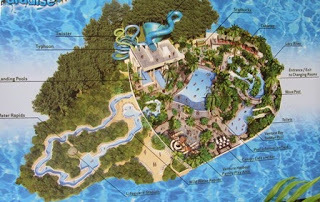
The full title for this is Subtropical Swimming Paradise, and with all the palms and other exotic plants, and the high temperature, that is certainly the effect that Center Parcs is so good at creating. I was surprised how different this one was from the other Center Parcs I have visited over the years.
 For one thing it seemed much smaller, and there was no large central pool, so there would have been nowhere for an adult to swim. In fact it was divided into a number of smaller areas, all quite child orientated, with a lot of wooden chairs for parents to watch their offspring. There were also a number of food outlets selling the inevitable chips etc and soft drinks.
For one thing it seemed much smaller, and there was no large central pool, so there would have been nowhere for an adult to swim. In fact it was divided into a number of smaller areas, all quite child orientated, with a lot of wooden chairs for parents to watch their offspring. There were also a number of food outlets selling the inevitable chips etc and soft drinks.One area that was very popular was pirate-themed, and every so often, and it seemed random, there would be a great rush of cascading water, which was proving very popular with the 'victims' waiting, bated breath, underneath.
 Also the 'Lazy River' looked rather appealing, with the water moving round slowly so no effort was required by the participants!
Also the 'Lazy River' looked rather appealing, with the water moving round slowly so no effort was required by the participants!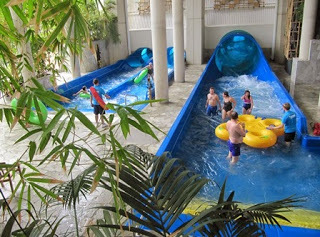 More lively were the numerous flumes and tubes which extended beyond the quite lovely building. It was impossible to see quite where there went from the outside, but a couple ended up in the main area and people were clearly having a whale of a time, and couldn't wait to scramble back up the stairs to do it all over again!
More lively were the numerous flumes and tubes which extended beyond the quite lovely building. It was impossible to see quite where there went from the outside, but a couple ended up in the main area and people were clearly having a whale of a time, and couldn't wait to scramble back up the stairs to do it all over again!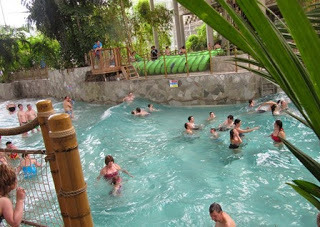 Of course there was the famous wave machine, now in quite a small, confined area and with a less noisy Tarzan warning sound than in say Sherwood Forest, but still proving very popular.
Of course there was the famous wave machine, now in quite a small, confined area and with a less noisy Tarzan warning sound than in say Sherwood Forest, but still proving very popular. Like most of Woburn Forest it seemed very child-orientated, especially towards young children. I felt too old by several decades, but it was still an interesting and enjoyable experience!
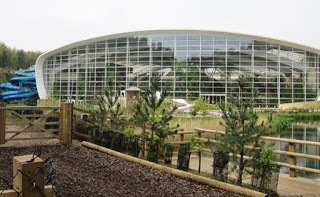 ***If you would like to know more about me and my writing just click here
***If you would like to know more about me and my writing just click here
Published on April 30, 2015 02:09
April 28, 2015
Center Parcs - Woburn Forest - Bedfordshire
I just love Center Parcs and have been going since the very first one opened in Nottinghamshire in 1987. Just click here to see my blogs about Longleat, Sherwood Forest and Whinfell Forest
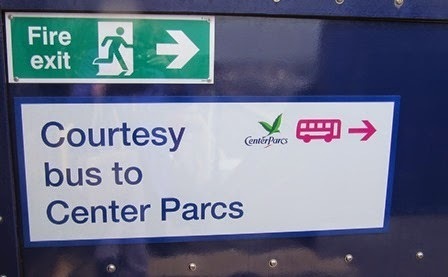 Now it was time to go and discover Woburn Forest, the new site that has been open less than a year. I travelled by train from Nottingham, and it was nice to see these signs on arriving at Flitwick station.
Now it was time to go and discover Woburn Forest, the new site that has been open less than a year. I travelled by train from Nottingham, and it was nice to see these signs on arriving at Flitwick station.
Then it was the short drive to the location, where, for the first time I was staying in an apartment in the hotel complex. This was very comfortable, with a lovely little balcony overlooking the water.
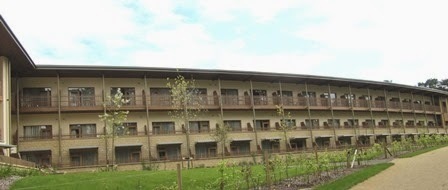
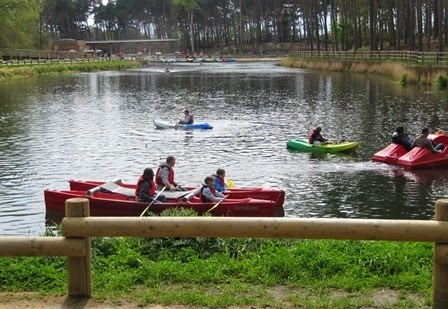 As usual with Center Parcs there was every activity you could possibly imagine, both inside and out, although everything was pretty expensive and a family could quickly spend a lot of money. I will be doing a separate blog about the Subtropical Swimming Paradise, which is always such a feature of Center Parcs, and is the only thing included in the booking fee.
As usual with Center Parcs there was every activity you could possibly imagine, both inside and out, although everything was pretty expensive and a family could quickly spend a lot of money. I will be doing a separate blog about the Subtropical Swimming Paradise, which is always such a feature of Center Parcs, and is the only thing included in the booking fee.
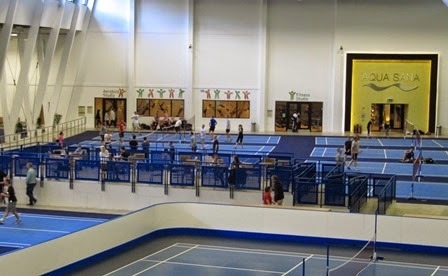 In many ways this was different from the other Parcs, very child-orientated, with everything like the lake on a much smaller scale than at say Sherwood.
In many ways this was different from the other Parcs, very child-orientated, with everything like the lake on a much smaller scale than at say Sherwood.
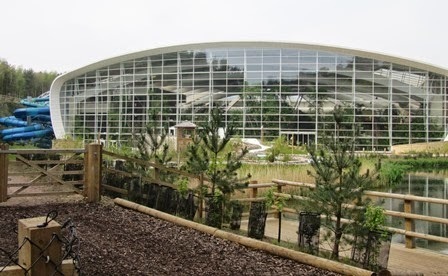
***If you would like to know more about me and my writing just click here
 Now it was time to go and discover Woburn Forest, the new site that has been open less than a year. I travelled by train from Nottingham, and it was nice to see these signs on arriving at Flitwick station.
Now it was time to go and discover Woburn Forest, the new site that has been open less than a year. I travelled by train from Nottingham, and it was nice to see these signs on arriving at Flitwick station.Then it was the short drive to the location, where, for the first time I was staying in an apartment in the hotel complex. This was very comfortable, with a lovely little balcony overlooking the water.

 As usual with Center Parcs there was every activity you could possibly imagine, both inside and out, although everything was pretty expensive and a family could quickly spend a lot of money. I will be doing a separate blog about the Subtropical Swimming Paradise, which is always such a feature of Center Parcs, and is the only thing included in the booking fee.
As usual with Center Parcs there was every activity you could possibly imagine, both inside and out, although everything was pretty expensive and a family could quickly spend a lot of money. I will be doing a separate blog about the Subtropical Swimming Paradise, which is always such a feature of Center Parcs, and is the only thing included in the booking fee. In many ways this was different from the other Parcs, very child-orientated, with everything like the lake on a much smaller scale than at say Sherwood.
In many ways this was different from the other Parcs, very child-orientated, with everything like the lake on a much smaller scale than at say Sherwood. 
***If you would like to know more about me and my writing just click here
Published on April 28, 2015 03:39
April 23, 2015
'Make Yourself Comfortable at Chatsworth' - Derbyshire
I just don't know how they do it! Every time I go to Chatsworth, which is pretty frequently, they have come up with something new, and I think 'This can't get any better' and then it does! They must have an amazing team of really imaginative people working there!
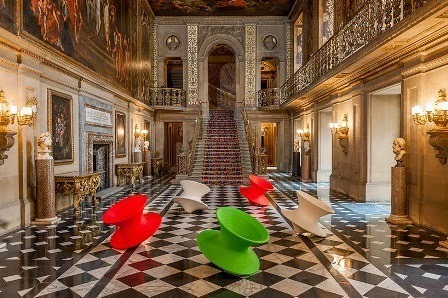 This latest exhibition is called 'Make Yourself Comfortable' and is a collection of contemporary seating by international designers. However, it isn't all roped off behind barriers or anything like that, the chairs are dotted around, and I hadn't at first realised this, but you can sit in any of them! In the Great Painted Hall are these stunning creations by Thomas Heatherwick. I must admit this is not my photo - I found it on the web, because when I was there it was impossible to get this view there were so many giggling Japanese teenagers having a great time! They were spinning around, and filming each other having a great time!
This latest exhibition is called 'Make Yourself Comfortable' and is a collection of contemporary seating by international designers. However, it isn't all roped off behind barriers or anything like that, the chairs are dotted around, and I hadn't at first realised this, but you can sit in any of them! In the Great Painted Hall are these stunning creations by Thomas Heatherwick. I must admit this is not my photo - I found it on the web, because when I was there it was impossible to get this view there were so many giggling Japanese teenagers having a great time! They were spinning around, and filming each other having a great time!
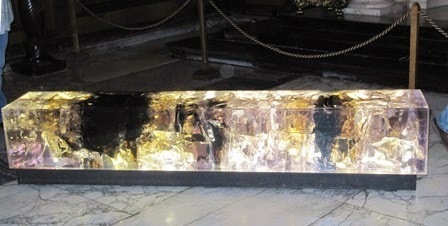 Something else which took my eye was in the Chapel and was called 'Counterpart', created by Tom Price. It was specially commissioned for this exhibition and actually consisted of two blocks, this one being a glowing transparent resin block, which referenced the giant quartz on display in the nearby corridor. Inside the resin were lumps of tar. According to a write-up I found on the web, a exothermic reaction takes place as the resin cures, which heats the tar, forcing it to expand into whatever limited space is available as the resin solidifies. The block, which was also being used as a bench, is illuminated to show the resulting fractures in the resin. Certainly something quite different to anything I'd seen before.
Something else which took my eye was in the Chapel and was called 'Counterpart', created by Tom Price. It was specially commissioned for this exhibition and actually consisted of two blocks, this one being a glowing transparent resin block, which referenced the giant quartz on display in the nearby corridor. Inside the resin were lumps of tar. According to a write-up I found on the web, a exothermic reaction takes place as the resin cures, which heats the tar, forcing it to expand into whatever limited space is available as the resin solidifies. The block, which was also being used as a bench, is illuminated to show the resulting fractures in the resin. Certainly something quite different to anything I'd seen before.
 However, my utter favourite area had to be the Dining Room, which I totally love anyway. Here I was amazed to find you could actually take a seat at the table - something I never envisaged being able to do! The 'tablecloth' was printed with the names of possible other guests, which was fun, but the best bit were the amazing 'place mats' which were so informative. Of course I had to move from one seat to the next to read as many as possible!
However, my utter favourite area had to be the Dining Room, which I totally love anyway. Here I was amazed to find you could actually take a seat at the table - something I never envisaged being able to do! The 'tablecloth' was printed with the names of possible other guests, which was fun, but the best bit were the amazing 'place mats' which were so informative. Of course I had to move from one seat to the next to read as many as possible!

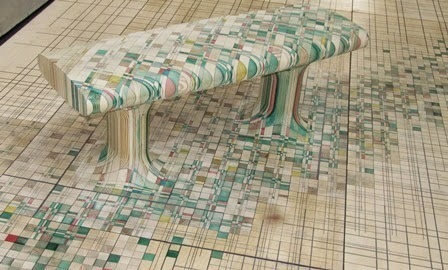 Then it was through to the Statue Gallery, where a completely new floor had been laid, as the decorative surface of the stools in here spilled over! An amazing concept.
Then it was through to the Statue Gallery, where a completely new floor had been laid, as the decorative surface of the stools in here spilled over! An amazing concept.
My only complaint was about the signage which was too small, and too low down to read - I think I managed one notice from the whole exhibition.
Now I'm really excited having discovered there's a tour of this exhibition taking place in June, and I can't wait to learn more about something so unique. Probably another blog on the way!
**** Want to know more about me? Just click here
 This latest exhibition is called 'Make Yourself Comfortable' and is a collection of contemporary seating by international designers. However, it isn't all roped off behind barriers or anything like that, the chairs are dotted around, and I hadn't at first realised this, but you can sit in any of them! In the Great Painted Hall are these stunning creations by Thomas Heatherwick. I must admit this is not my photo - I found it on the web, because when I was there it was impossible to get this view there were so many giggling Japanese teenagers having a great time! They were spinning around, and filming each other having a great time!
This latest exhibition is called 'Make Yourself Comfortable' and is a collection of contemporary seating by international designers. However, it isn't all roped off behind barriers or anything like that, the chairs are dotted around, and I hadn't at first realised this, but you can sit in any of them! In the Great Painted Hall are these stunning creations by Thomas Heatherwick. I must admit this is not my photo - I found it on the web, because when I was there it was impossible to get this view there were so many giggling Japanese teenagers having a great time! They were spinning around, and filming each other having a great time! Something else which took my eye was in the Chapel and was called 'Counterpart', created by Tom Price. It was specially commissioned for this exhibition and actually consisted of two blocks, this one being a glowing transparent resin block, which referenced the giant quartz on display in the nearby corridor. Inside the resin were lumps of tar. According to a write-up I found on the web, a exothermic reaction takes place as the resin cures, which heats the tar, forcing it to expand into whatever limited space is available as the resin solidifies. The block, which was also being used as a bench, is illuminated to show the resulting fractures in the resin. Certainly something quite different to anything I'd seen before.
Something else which took my eye was in the Chapel and was called 'Counterpart', created by Tom Price. It was specially commissioned for this exhibition and actually consisted of two blocks, this one being a glowing transparent resin block, which referenced the giant quartz on display in the nearby corridor. Inside the resin were lumps of tar. According to a write-up I found on the web, a exothermic reaction takes place as the resin cures, which heats the tar, forcing it to expand into whatever limited space is available as the resin solidifies. The block, which was also being used as a bench, is illuminated to show the resulting fractures in the resin. Certainly something quite different to anything I'd seen before. However, my utter favourite area had to be the Dining Room, which I totally love anyway. Here I was amazed to find you could actually take a seat at the table - something I never envisaged being able to do! The 'tablecloth' was printed with the names of possible other guests, which was fun, but the best bit were the amazing 'place mats' which were so informative. Of course I had to move from one seat to the next to read as many as possible!
However, my utter favourite area had to be the Dining Room, which I totally love anyway. Here I was amazed to find you could actually take a seat at the table - something I never envisaged being able to do! The 'tablecloth' was printed with the names of possible other guests, which was fun, but the best bit were the amazing 'place mats' which were so informative. Of course I had to move from one seat to the next to read as many as possible!
 Then it was through to the Statue Gallery, where a completely new floor had been laid, as the decorative surface of the stools in here spilled over! An amazing concept.
Then it was through to the Statue Gallery, where a completely new floor had been laid, as the decorative surface of the stools in here spilled over! An amazing concept.My only complaint was about the signage which was too small, and too low down to read - I think I managed one notice from the whole exhibition.
Now I'm really excited having discovered there's a tour of this exhibition taking place in June, and I can't wait to learn more about something so unique. Probably another blog on the way!
**** Want to know more about me? Just click here
Published on April 23, 2015 02:49
April 21, 2015
'Skylarks' - Nottinghamshire Wildlife Trust - Nature Reserve
 Recently I attended the 'Skylarks Open Day' but this turned out to be a non-event, but fortunately I was directed over the road to the original reserve, and was able to enjoy a really nice walk - the area I've gridded on the map. It's just off Adbolton Lane, near Holme Pierrepoint Water Sports.
Recently I attended the 'Skylarks Open Day' but this turned out to be a non-event, but fortunately I was directed over the road to the original reserve, and was able to enjoy a really nice walk - the area I've gridded on the map. It's just off Adbolton Lane, near Holme Pierrepoint Water Sports.
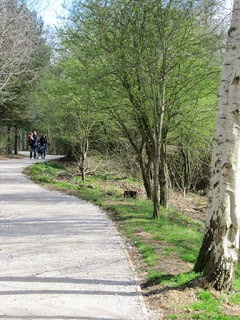 This Nature Reserve was created by Notts Wildlife Trust in 1982, and was specifically designed to that it's wheelchair friendly, and was the first nature reserve in the UK with this specific aim. Skylarks was once a commercial gravel pit but as result of careful management is now a valuable wetland habitat for a variety of wildlife. The water is home to great crested grebes, kingfishers and reed buntings, as well as skylarks and lapwings. In winter redwing and fieldfare visit the site, and in summer common tern, yellow wagtail, reed warbler and sedge warblers are regular visitors. During the warmer summer months damselflies and dragonflies fly above the water's surface, and hover amongst the reeds. Butterflies abound including the meadow brown, common blue, small heath and orange tip, whilst the varied flora includes marsh marigold, oxlip and coswlip and the delicate Southern marsh and spotted orchids grow here. When I visited the paths had recently been resurfaced following extensive rabbit damage, and were now really easy for pushchairs etc.
This Nature Reserve was created by Notts Wildlife Trust in 1982, and was specifically designed to that it's wheelchair friendly, and was the first nature reserve in the UK with this specific aim. Skylarks was once a commercial gravel pit but as result of careful management is now a valuable wetland habitat for a variety of wildlife. The water is home to great crested grebes, kingfishers and reed buntings, as well as skylarks and lapwings. In winter redwing and fieldfare visit the site, and in summer common tern, yellow wagtail, reed warbler and sedge warblers are regular visitors. During the warmer summer months damselflies and dragonflies fly above the water's surface, and hover amongst the reeds. Butterflies abound including the meadow brown, common blue, small heath and orange tip, whilst the varied flora includes marsh marigold, oxlip and coswlip and the delicate Southern marsh and spotted orchids grow here. When I visited the paths had recently been resurfaced following extensive rabbit damage, and were now really easy for pushchairs etc.
 There was also pond dipping taking place and how popular that was proving to be! Not only were several Rangers on hand to help explain the process, but a table had been set up so it was easy to examine the various 'finds'. This is a view through the magnifying glass, which I thought was a really good way of showing little ones what was in their nets!
There was also pond dipping taking place and how popular that was proving to be! Not only were several Rangers on hand to help explain the process, but a table had been set up so it was easy to examine the various 'finds'. This is a view through the magnifying glass, which I thought was a really good way of showing little ones what was in their nets!***For more about me and my writing just click here
Published on April 21, 2015 03:42
April 13, 2015
Easton Walled Gardens 2015 - Lincolnshire
I couldn't believe it was so long since I last visited this very special place - see previous blog.
One of the many things I really love about Easton is the many informative notice boards, explaining exactly what they are doing and why. This makes it absolutely fascinating.

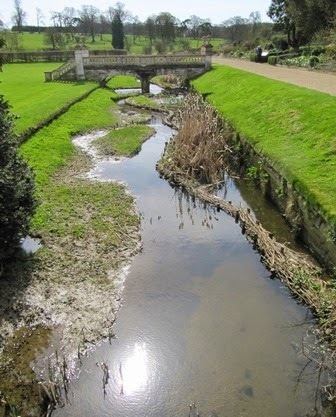 The biggest change was down at the river. I'd never seen anything like this, but it was interesting how by changing the banks the flow and depth of the water could be changed. It must have involved a huge amount of work, but it was already possible to see the improvement in the flow of the crystal clear water.
The biggest change was down at the river. I'd never seen anything like this, but it was interesting how by changing the banks the flow and depth of the water could be changed. It must have involved a huge amount of work, but it was already possible to see the improvement in the flow of the crystal clear water.
Altogether it was another absolutely fascinating visit, plus a tasty lunch. I just wish Easton Walled Garden was nearer and then I could visit every month - something amazing would be happening each time I'm sure!

***For more about me and my writing just click here
One of the many things I really love about Easton is the many informative notice boards, explaining exactly what they are doing and why. This makes it absolutely fascinating.

 The biggest change was down at the river. I'd never seen anything like this, but it was interesting how by changing the banks the flow and depth of the water could be changed. It must have involved a huge amount of work, but it was already possible to see the improvement in the flow of the crystal clear water.
The biggest change was down at the river. I'd never seen anything like this, but it was interesting how by changing the banks the flow and depth of the water could be changed. It must have involved a huge amount of work, but it was already possible to see the improvement in the flow of the crystal clear water.Altogether it was another absolutely fascinating visit, plus a tasty lunch. I just wish Easton Walled Garden was nearer and then I could visit every month - something amazing would be happening each time I'm sure!

***For more about me and my writing just click here
Published on April 13, 2015 02:21



